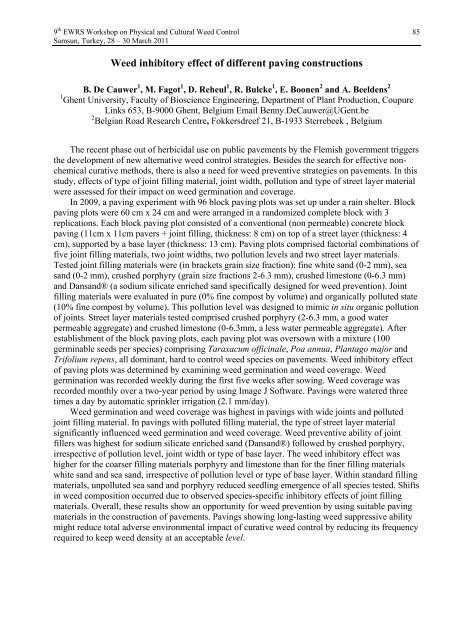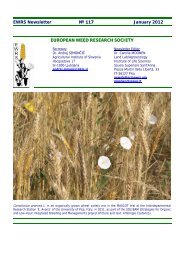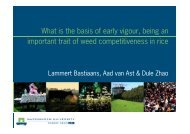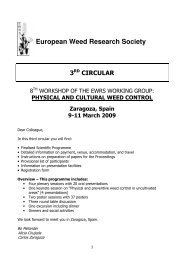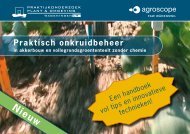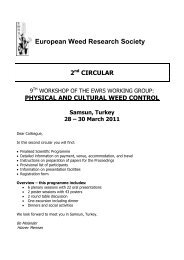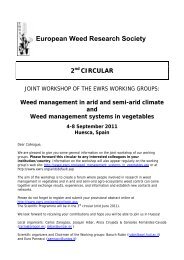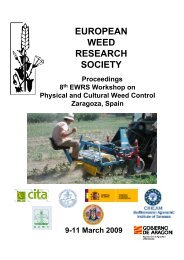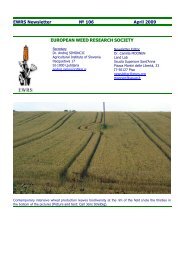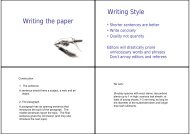Physical and Cultural Weed Control Working Group of - European ...
Physical and Cultural Weed Control Working Group of - European ...
Physical and Cultural Weed Control Working Group of - European ...
Create successful ePaper yourself
Turn your PDF publications into a flip-book with our unique Google optimized e-Paper software.
9 th EWRS Workshop on <strong>Physical</strong> <strong>and</strong> <strong>Cultural</strong> <strong>Weed</strong> <strong>Control</strong> 85<br />
Samsun, Turkey, 28 – 30 March 2011<br />
<strong>Weed</strong> inhibitory effect <strong>of</strong> different paving constructions<br />
B. De Cauwer 1 , M. Fagot 1 , D. Reheul 1 , R. Bulcke 1 , E. Boonen 2 <strong>and</strong> A. Beeldens 2<br />
1 Ghent University, Faculty <strong>of</strong> Bioscience Engineering, Department <strong>of</strong> Plant Production, Coupure<br />
Links 653, B-9000 Ghent, Belgium Email Benny.DeCauwer@UGent.be<br />
2 Belgian Road Research Centre, Fokkersdreef 21, B-1933 Sterrebeek , Belgium<br />
The recent phase out <strong>of</strong> herbicidal use on public pavements by the Flemish government triggers<br />
the development <strong>of</strong> new alternative weed control strategies. Besides the search for effective nonchemical<br />
curative methods, there is also a need for weed preventive strategies on pavements. In this<br />
study, effects <strong>of</strong> type <strong>of</strong> joint filling material, joint width, pollution <strong>and</strong> type <strong>of</strong> street layer material<br />
were assessed for their impact on weed germination <strong>and</strong> coverage.<br />
In 2009, a paving experiment with 96 block paving plots was set up under a rain shelter. Block<br />
paving plots were 60 cm x 24 cm <strong>and</strong> were arranged in a r<strong>and</strong>omized complete block with 3<br />
replications. Each block paving plot consisted <strong>of</strong> a conventional (non permeable) concrete block<br />
paving (11cm x 11cm pavers + joint filling, thickness: 8 cm) on top <strong>of</strong> a street layer (thickness: 4<br />
cm), supported by a base layer (thickness: 13 cm). Paving plots comprised factorial combinations <strong>of</strong><br />
five joint filling materials, two joint widths, two pollution levels <strong>and</strong> two street layer materials.<br />
Tested joint filling materials were (in brackets grain size fraction): fine white s<strong>and</strong> (0-2 mm), sea<br />
s<strong>and</strong> (0-2 mm), crushed porphyry (grain size fractions 2-6.3 mm), crushed limestone (0-6.3 mm)<br />
<strong>and</strong> Dans<strong>and</strong>® (a sodium silicate enriched s<strong>and</strong> specifically designed for weed prevention). Joint<br />
filling materials were evaluated in pure (0% fine compost by volume) <strong>and</strong> organically polluted state<br />
(10% fine compost by volume). This pollution level was designed to mimic in situ organic pollution<br />
<strong>of</strong> joints. Street layer materials tested comprised crushed porphyry (2-6.3 mm, a good water<br />
permeable aggregate) <strong>and</strong> crushed limestone (0-6.3mm, a less water permeable aggregate). After<br />
establishment <strong>of</strong> the block paving plots, each paving plot was oversown with a mixture (100<br />
germinable seeds per species) comprising Taraxacum <strong>of</strong>ficinale, Poa annua, Plantago major <strong>and</strong><br />
Trifolium repens, all dominant, hard to control weed species on pavements. <strong>Weed</strong> inhibitory effect<br />
<strong>of</strong> paving plots was determined by examining weed germination <strong>and</strong> weed coverage. <strong>Weed</strong><br />
germination was recorded weekly during the first five weeks after sowing. <strong>Weed</strong> coverage was<br />
recorded monthly over a two-year period by using Image J S<strong>of</strong>tware. Pavings were watered three<br />
times a day by automatic sprinkler irrigation (2.1 mm/day).<br />
<strong>Weed</strong> germination <strong>and</strong> weed coverage was highest in pavings with wide joints <strong>and</strong> polluted<br />
joint filling material. In pavings with polluted filling material, the type <strong>of</strong> street layer material<br />
significantly influenced weed germination <strong>and</strong> weed coverage. <strong>Weed</strong> preventive ability <strong>of</strong> joint<br />
fillers was highest for sodium silicate enriched s<strong>and</strong> (Dans<strong>and</strong>®) followed by crushed porphyry,<br />
irrespective <strong>of</strong> pollution level, joint width or type <strong>of</strong> base layer. The weed inhibitory effect was<br />
higher for the coarser filling materials porphyry <strong>and</strong> limestone than for the finer filling materials<br />
white s<strong>and</strong> <strong>and</strong> sea s<strong>and</strong>, irrespective <strong>of</strong> pollution level or type <strong>of</strong> base layer. Within st<strong>and</strong>ard filling<br />
materials, unpolluted sea s<strong>and</strong> <strong>and</strong> porphyry reduced seedling emergence <strong>of</strong> all species tested. Shifts<br />
in weed composition occurred due to observed species-specific inhibitory effects <strong>of</strong> joint filling<br />
materials. Overall, these results show an opportunity for weed prevention by using suitable paving<br />
materials in the construction <strong>of</strong> pavements. Pavings showing long-lasting weed suppressive ability<br />
might reduce total adverse environmental impact <strong>of</strong> curative weed control by reducing its frequency<br />
required to keep weed density at an acceptable level.


